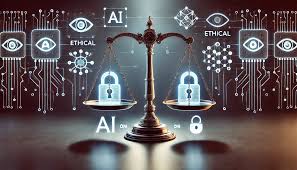
“Empowering the Future: AI Leading the Charge for Safer Digital Spaces”

In today’s hyperconnected world, cybersecurity is no longer just a concern for large corporations or government institutions—it’s a necessity for everyone. From protecting personal data to safeguarding national security, the stakes are higher than ever before. Fortunately, artificial intelligence (AI) is emerging as a powerful ally in the battle against cyber threats. With its unparalleled ability to analyze, adapt, and learn, AI is transforming cybersecurity into a proactive and dynamic force that is capable of keeping pace with the ever-evolving landscape of digital dangers.
Artificial Intelligence (AI) is rapidly reshaping the landscape of cybersecurity, acting as a transformative force that is strengthening digital defenses across the globe. By harnessing its capacity for rapid data analysis, adaptive learning, and predictive accuracy, AI has become an essential tool in combating an ever-evolving spectrum of cyber threats.
Unlike traditional cybersecurity measures, which often rely on predefined rules, AI operates dynamically, identifying new patterns and anomalies in real time to detect and neutralize potential risks before they cause harm. Its applications range from fortifying networks and systems against breaches to automating routine security tasks, enabling human experts to focus on more strategic challenges. Moreover, AI’s predictive capabilities are empowering organizations to anticipate future vulnerabilities and proactively enhance their defenses, fostering a forward-looking approach to cybersecurity.
However, as AI takes on a more central role, it is essential to address ethical concerns, such as ensuring transparency, safeguarding data privacy, and mitigating biases in AI algorithms. This collaboration between technology and humanity is not just about protecting data—it’s about building trust and creating a digital future where innovation and security thrive in harmony. AI is not only revolutionizing how we tackle cyber threats but also inspiring confidence in the potential of technology to be a force for good in our increasingly connected world.
Agentic AI
The Growing Challenge of Cyber Threats

The digital revolution has brought tremendous benefits, from improved communication and global collaboration to innovative solutions across industries. However, it has also given rise to increasingly sophisticated cybercriminals who exploit vulnerabilities for financial gain, espionage, or sheer disruption. Traditional methods of cybersecurity, while effective in their time, struggle to keep up with the scale and complexity of modern attacks. Malware, ransomware, phishing, and denial-of-service attacks are just a few of the threats that organizations and individuals face daily.
As cyber threats continue to grow in volume and sophistication, the question arises: how can we stay one step ahead? The answer lies in leveraging cutting-edge technology, and AI is at the forefront of this effort.
AI as a Game-Changer in Cybersecurity

AI’s ability to process vast amounts of data and identify patterns makes it an invaluable asset in cybersecurity. Here are some key ways AI is leading the charge for safer digital spaces:
- Real-Time Threat Detection and Response AI-powered systems can monitor networks and devices around the clock, identifying anomalies and potential threats in real time. By analyzing behavior patterns and flagging suspicious activities, AI enables rapid responses to attacks, minimizing damage and disruption.
- Predictive Analysis Rather than simply reacting to threats, AI can anticipate potential vulnerabilities and predict future attacks. By analyzing historical data and trends, AI helps organizations proactively strengthen their defenses and stay ahead of cybercriminals.
- Automated Solutions With AI, routine tasks such as software updates, system scans, and threat mitigation can be automated. This not only improves efficiency but also frees up cybersecurity professionals to focus on strategic initiatives.
- Enhanced Accuracy AI algorithms can distinguish between genuine threats and false alarms with greater accuracy than traditional methods. This reduces unnecessary interventions and ensures that resources are allocated effectively.
- Adaptability Cyber threats are constantly evolving, and AI systems can adapt in real time, learning from new data and updating their strategies accordingly. This dynamic approach ensures that defenses remain relevant and effective.
Collaboration Between Humans and AI

While AI is undoubtedly a powerful tool, it is not a standalone solution. Human expertise remains critical in interpreting AI-generated insights and making strategic decisions. The collaboration between humans and AI creates a symbiotic relationship where technology enhances human capabilities, and humans provide context and judgment that machines cannot replicate.
The Ethical Dimension

As we embrace AI in cybersecurity, it’s essential to consider ethical implications. Transparency, accountability, and privacy must be prioritized to ensure that AI is used responsibly. Striking the right balance between security and personal freedoms is key to building trust in AI-powered systems.
Looking Ahead
The future of cybersecurity is bright, thanks to AI’s transformative impact. By empowering organizations with tools that are faster, smarter, and more effective, AI is paving the way for a safer digital world. From protecting sensitive data to enabling secure online transactions, AI is a beacon of hope in the fight against cybercrime.
As we continue to innovate and harness the potential of AI, one thing is clear: the journey to secure digital spaces is far from over. However, with AI leading the charge, we are more equipped than ever to tackle the challenges ahead and build a future where technology serves as a force for good.






